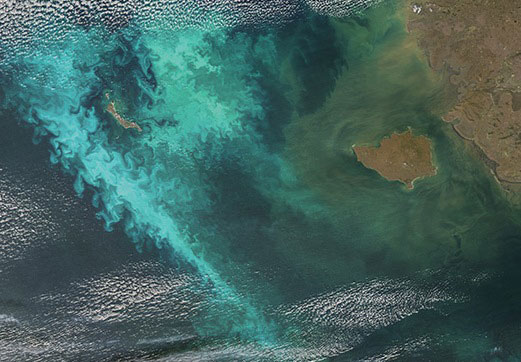Ocean color radiometry provides a vital Earth observation data record, which is important for monitoring water quality and water resources, ecological forecasting, detecting and assessing harmful algal blooms, and many other applications. For these reasons, NASA has invested in ocean color missions for several decades, which have accumulated a plethora of ocean color data and benefited many societal and economic applications.
Despite the great progress, it remains a challenging task to perform ocean color remote sensing in complex scenes involving absorbing aerosols, and coastal and in-land waters due to complicate transportation process of light between the atmosphere and ocean. This has restrained the community’s ability to understand the global water cycle, primarily in terms of water quality. In recent years, new technologies and remote sensing methods are proposed to improve ocean color retrieval in coastal regions. The use of polarimetric data is one of the most promising methods that can improve ocean color imagery interpretation and lead to better ocean property remote sensing.
Pengwang Zhai, assistant professor of physics, is an expert in light transport in atmosphere and ocean environment. He and co-investigators propose to tackle this complicate problem by combining polarimetric and ocean color radiometric observation. Polarimetric observation will be used to characterize aerosol size and composition, which will in turn be used to identify and separate light contributions from the atmosphere and ocean, a procedure called atmospheric correction. Atmospheric correction is a necessary step towards appropriate interpretation of ocean color imagery.
NASA has selected Dr. Zhai’s research team to receive an award to perform the proposed research. Dr. Zhai, as the PI, will lead this research, which involves collaboration among researchers from UMBC, NASA's Goddard Space Flight Center, NASA’s Langley Research Center, and Universities Space Research Association. Upon successful development, this research will contribute the community with a reliable and accurate ocean color retrieval algorithm that is applicable to large geographical areas and more accurate environmental data record.
Despite the great progress, it remains a challenging task to perform ocean color remote sensing in complex scenes involving absorbing aerosols, and coastal and in-land waters due to complicate transportation process of light between the atmosphere and ocean. This has restrained the community’s ability to understand the global water cycle, primarily in terms of water quality. In recent years, new technologies and remote sensing methods are proposed to improve ocean color retrieval in coastal regions. The use of polarimetric data is one of the most promising methods that can improve ocean color imagery interpretation and lead to better ocean property remote sensing.
Pengwang Zhai, assistant professor of physics, is an expert in light transport in atmosphere and ocean environment. He and co-investigators propose to tackle this complicate problem by combining polarimetric and ocean color radiometric observation. Polarimetric observation will be used to characterize aerosol size and composition, which will in turn be used to identify and separate light contributions from the atmosphere and ocean, a procedure called atmospheric correction. Atmospheric correction is a necessary step towards appropriate interpretation of ocean color imagery.
NASA has selected Dr. Zhai’s research team to receive an award to perform the proposed research. Dr. Zhai, as the PI, will lead this research, which involves collaboration among researchers from UMBC, NASA's Goddard Space Flight Center, NASA’s Langley Research Center, and Universities Space Research Association. Upon successful development, this research will contribute the community with a reliable and accurate ocean color retrieval algorithm that is applicable to large geographical areas and more accurate environmental data record.
A large phytoplankton blooms captured by NASA MODIS-AQUA sensor on 8 October 2014. Browner, sediment-laden waters are also visible along the coast of Alaska. Image Credit: NASA Ocean Biology Processing Group (OBPG)
Posted: August 7, 2017, 12:08 PM

